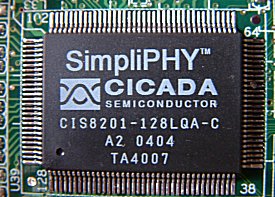Layout and features

EPoX's traditional green PCB colouring on show once again. It's strange to think that a manufacturer so intent on offering the enthusiast every conceivable BIOS and performance option hasn't distinguished its boards with a funky colour. DFI's a company that's just done that, especially with the LANPARTY line of boards. Initial impressions are good. There's six PCI slots; that's a rarity it itself these days. We like the masses of room surround the CPU socket, no doubt helped by the single-chip design. Cooling installation and removal is a breeze, even if the board's locked inside a case.

We've never been fans of having power plugs, in this case both 20-pin and 4-pin, located on the far side of the board. The snake-line power cables can cause unwanted mess and block scarce airflow. This positioning has been a trait of EPoX's for a while now, though. EPoX uses the same beefy 3300uF capacitors found on the VIA K8T800-powered 8HDA3+, so no surprises there. Indeed, the overall design carries many similar themes to the firm's first Socket 754 board. 2 fan headers close the CPU socket is a good idea.
Having three DDR slots has historically been a guarantee of 3GB system RAM that's run at maximum chipset-rated speed. That's not the case here. The use of 3 DIMMs heavily compromises DDR400 usage. The manual carefully states that DDR400 RAM speeds are only guaranteed with a maximum of two DIMMs. We'll also do well to remember that S754 CPUs use single-channel memory, so dual kits are of little immediate use.
The free room around the CPU socket and three DIMM slots have come at a design cost. Primary and secondary IDE ports have been pushed down towards the left-hand side of the 8KDA3+. It's not a bad thing, really, although users with extra-long PCI cards may find the placement a little restrictive. If the nForce3 250Gb stands out in any one area, it absolutely has to be storage and RAID potential. Not only are the IDE ports RAIDable out of the box, NVIDIA has also tacked on RAIDable on-chip SATA support. All sorts of weird and wonderful IDE and SATA RAID opportunities arise, backed up by NVIDIA's handy software.

Two out of a possible four ports are located on the upper side of the 8X AGP slot. One problem we can forsee is hooking up cables when cards with large rear-mounted heatsinks are used. EPoX has decided to forego using an optional physical layer to provide another 2 ports. The reasoning lies with the use of Silicon Image's PCI-ridin' Sil3114 4-port SATA controller. An aside, EPoX's use of 6 PCI slots pushes the AGP port higher up the board. That results in the unavoidable annoyance of not being able to remove system memory when a large card is inserted.

A close-up for the extreme left-hand side shows the controller at the top of the shot. 4 SATA ports are naturally located close by. It's a difficult choice to make. Does a manufacturer choose to extend on-chip usage with a PHY or does it specify an add-on controller. EPoX feels as if the latter is the best option. We're not duly concerned as a number of bandwidth-eating peripherals, including Gigabit Ethernet, have been grafted on the single-chip design, thereby sparing the PCI bus.
Silicon Image's controller is no slouch. It provides hot-plug support and, more saliently, independent, RAID0, RAID1, and RAID0+1 functions. It's also easy to setup, too. The downside is cost. Silicon Image currently charges $12.50 in quantities of 10k. That's a significant portion of a manufacturer's board-making cost. We like the floppy port's position and the funky coloured case-to-motherboard pins (I apologise for my macro fetish :). More good is to be found in the debug LCD screen and easily accessible CMOS jumper location. What's not so good is the absence, once again, of FireWire support. It's increasingly playing second fiddle to USB 2.0 in the high-speed connectivity stakes, yet it's just as useful.

Onboard sound has been slow to evolve in comparison to, say, graphics cards and even networking. EPoX plumps for Realtek's new ALC850 sound CODEC. The model numbering scheme informs us that this is an eight-channel (7.1) AC'97 Rev 2.3 (auto jack-sensing) IC; definitely on the premium side, and definitely appreciated by us.

One of the nForce3 250Gb's revised benefits is on-chip Gigabit Ethernet. However, like many of NVIDIA's features, an external physical layer is needed for routing to the outside world. Cicada's SimpliPHY transceiver does just that.

A slightly unusual back panel. EPoX has added both optical and coaxial S/PDIF-Out jacks and also included legacy support in the form of one Parallel and one Serial port. 4 out of a possible 8 USB2.0 ports is enough for a back panel, we feel. An RJ45 connector hooks up to the Cicada transceiver for Gigabit Ethernet lovin'. A block of 6 audio ports can accommodate 8-channel sound, made up of 2 front speakers (green), 2 rears (black), 2 side speakers (grey), and centre & subwoofer (orange). A well-specified and laid out board that's letdown by a lack of FireWire support.









